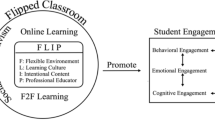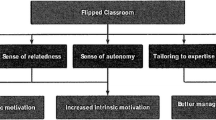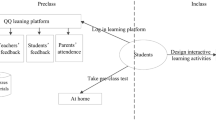Abstract
The purpose of this study was to investigate prospective middle school mathematics teachers’ views on the flipped classroom. 41 third-year undergraduate students who were enrolled in the mathematics education department participated in this qualitative study. The study was conducted in the Statistics and Probability course and lasted for 11 weeks. Findings were organized under four themes as positive opinions, negative opinions, suggestions and the use of flipped classrooms in mathematics teaching. The findings showed that flipped classrooms had positive effects on prospective teachers’ active participation in the lesson, self-regulation and teamwork skills. On the other hand, not making any revision of the subjects during the course and technical problems were found as the negative sides of the flipped classroom. The findings showed that it was important to establish a mechanism for arranging the self-regulation of students. In this context, Kahoot activities could be a useful way to make sure all students watch lecture videos before the class. It was also found that prospective teachers had different opinions on the use of flipped classrooms in mathematics teaching. Some prospective teachers would tend to use flipped learning when they start their careers for students to come prepared for the course and be responsible for their learning process. However, it was found that some prospective teachers would not implement flipped learning in their lessons since mathematics education should be only be carried out traditionally.


Similar content being viewed by others
References
Adams, C., & Dove, A. (2018). Calculus students flipped out: The impact of flipped learning on Calculus students’ achievement and perceptions of learning. PRIMUS, 28(6), 600–615. https://doi.org/10.1080/10511970.2017.1332701.
Adnan, M. (2017). Perceptions of senior-year ELT students for flipped classroom: A materials development course. Computer Assisted Language Learning, 30(3–4), 204–222. https://doi.org/10.1080/09588221.2017.1301958.
Altemueller, L., & Lindquist, C. (2017). Flipped classroom instruction for inclusive learning. British Journal of Special Education, 44(3), 341–358.
Al-Zahrani, A. M. (2015). From passive to active: The impact of the flipped classroom through social learning platforms on higher education students' creative thinking. British Journal of Educational Technology, 46(6), 1133–1148. https://doi.org/10.1111/bjet.12353.
Asef-Vaziri, A. (2015). The flipped classroom of operations management: A not-for-cost-reduction platform. Decision Sciences Journal of Innovative Education, 13(1), 71–89.
Bhagat, K. K., Chang, C. N., & Chang, C. Y. (2016). The impact of the flipped classroom on mathematics concept learning in high school. Educational Technology & Society, 19(3), 134–142.
Blau, I., & Shamir-Inbal, T. (2017). Re-designed flipped learning model in an academic course: The role of co-creation and co-regulation. Computers & Education, 115, 69–81. https://doi.org/10.1016/j.compedu.2017.07.014.
Brooks, A. W. (2014). Information literacy and the flipped classroom: Examining the impact of a one-shot flipped class on student learning and perceptions. Communications in Information Literacy, 8(2), 225–235. https://doi.org/10.15760/comminfolit.2014.8.2.168.
Chuang, H. H., Weng, C. Y., & Chen, C. H. (2018). Which students benefit most from a flipped classroom approach to language learning? British Journal of Educational Technology, 49(1), 56–68. https://doi.org/10.1111/bjet.12530.
Cronhjort, M., Filipsson, L., & Weurlander, M. (2017). Improved engagement and learning in flipped-classroom calculus. Teaching Mathematics and its Applications: An International Journal of the IMA, 37(3), 113–121. https://doi.org/10.1093/teamat/hrx007.
Cummins-Sebree, S. E., & White, E. (2014). Using the flipped classroom design: Student impressions and lessons learned. AURCO Journal, 20, 50–64.
Danker, B. (2015). Using flipped classroom approach to explore deep learning in large classrooms. IAFOR Journal of Education, 3(1), 171–186.
Davies, R. S., Dean, D. L., & Ball, N. (2013). Flipping the classroom and instructional technology integration in a college-level information systems spreadsheet course. Educational Technology Research and Development, 61(4), 563–580. https://doi.org/10.1007/s11423-013-9305-6.
Dill, E.M. (2012). The impact of flip teaching on student homework completion, behavior, engagement, and proficiency. Completed to meet the requirements of university of New England MS Ed. Program.
Elmaadaway, M. A. N. (2018). The effects of a flipped classroom approach on class engagement and skill performance in a blackboard course. British Journal of Educational Technology, 49(3), 479–491. https://doi.org/10.1111/bjet.12553.
Fang, Y. (2017). The Design of Learning Activity in flipped classroom based on deep learning theory. In 2nd international conference on humanities science, management and education technology (pp. 84-87).
Filiz, O., & Kurt, A. A. (2015). Flipped learning: Misunderstandings and the truth. Journal of Educational Sciences Research, 5(1), 215–229. https://doi.org/10.12973/jesr.2015.51.13.
Findlay-Thompson, S., & Mombourquette, P. (2014). Evaluation of a flipped classroom in an undergraduate business course. Business Education & Accreditation, 6(1), 63–71.
Galway, L. P., Corbett, K. K., Takaro, T. K., Tairyan, K., & Frank, E. (2014). A novel integration of online and flipped classroom instructional models in public health higher education. BMC Medical Education, 14, 1–9.
Göğebakan-Yıldız, D., Kıyıcı, G., & Altıntaş, G. (2016). A research into the flipped classroom in terms of the academic achievement, and views of the prospective teachers. Sakarya University Journal of Education, 6(3), 186–200. https://doi.org/10.19126/suje.281368.
Hao, Y., & Lee, K. S. (2016). Teaching in flipped classrooms: Exploring pre-service teachers' concerns. Computers in Human Behavior, 57, 250–260. https://doi.org/10.1016/j.chb.2015.12.022.
Jacot, M. T., Noren, J., & Berge, Z. L. (2014). The flipped classroom in training and development: Fad or the future? Performance Improvement, 53(9), 23–28. https://doi.org/10.1002/pfi.21438.
Jamaludin, R., & Osman, S. Z. M. (2014). The use of a flipped classroom to enhance engagement and promote active learning. Journal of Education and Practice, 5(2), 124–131.
Jaster, R.W. (2013). Inverting the classroom in college algebra: An examination of student perceptions and engagement and their effects on grade outcomes. (Unpublished doctoral dissertation). Texas State University, San Marcos, Texas.
Karabulut-Ilgu, A., Jaramillo-Cherrez, N., & Jahren, C. T. (2018). A systematic review of research on the flipped learning method in engineering education. British Journal of Educational Technology, 49(3), 398–411. https://doi.org/10.1111/bjet.12548.
Kay, R., & Kletskin, I. (2012). Evaluating the use of problem-based video podcasts to teach mathematics in higher education. Computers & Education, 59(2), 619–627. https://doi.org/10.1016/j.compedu.2012.03.007.
Kayan, F., & Çakıroğlu, E. (2008). Pre-service elementary mathematics teachers’ mathematical problem-solving beliefs. Hacettepe University Journal of Education, 35(35), 218–226.
Kong, S. C. (2014). Developing information literacy and critical thinking skills through domain knowledge learning in digital classrooms: An experience of practicing flipped classroom strategy. Computers & Education, 78, 160–173. https://doi.org/10.1016/j.compedu.2014.05.009.
Lai, C. L., & Hwang, G. J. (2016). A self-regulated flipped classroom approach to improving students’ learning performance in a mathematics course. Computers and Education, 100, 126–140. https://doi.org/10.1016/j.compedu.2016.05.00.
La-Marca, A., & Longo, L. (2017). Addressing student motivation, self-regulation, and engagement in flipped classroom to decrease boredom. International Journal of Information and Education Technology, 7(3), 230–235. https://doi.org/10.18178/ijiet.2017.7.3.871.
Lo, C. K., & Hew, K. F. (2017). A critical review of flipped classroom challenges in K-12 education: Possible solutions and recommendations for future research. Research and Practice in Technology Enhanced Learning, 12(1), 4. https://doi.org/10.1186/s41039-016-0044-2.
Love, B., Hodge, A., Grandgenett, N., & Swift, A. W. (2014). Student learning and perceptions in a flipped linear algebra course. International Journal of Mathematical Education in Science and Technology, 45(3), 317–324. https://doi.org/10.1080/0020739X.2013.822582.
Mason, G. S., Shuman, T. R., & Cook, K. E. (2013). Comparing the effectiveness of an inverted classroom to a traditional classroom in an upper-division engineering course. IEEE Transactions on Education, 56(4), 430–435. https://doi.org/10.1109/TE.2013.2249066.
Mayer, R. E. (2009). Learning and instruction. Upper Saddle River: Pearson/ Merrill/ Prentice Hall.
Merriam, S. B., & Tisdell, E. J. (2015). Qualitative research: A guide to design and implementation. John Wiley & Sons.
Ministry of National Education [MoNE]. (2018). Curriculum of mathematics for 1–8 th grades. Ankara.
Moos, D. C., & Bonde, C. (2016). Flipping the classroom: Embedding self-regulated learning prompts in videos. Technology, Knowledge and Learning, 21(2), 225–242. https://doi.org/10.1007/s10758-015-9269-1.
National Council of Teachers of Mathematics [NCTM]. (2014). Principles to Actions: Executive Summary.
Novak, J., Kensington-Miller, B., & Evans, T. (2017). Flip or flop? Students’ perspectives of a flipped lecture in mathematics. International Journal of Mathematical Education in Science and Technology, 48(5), 647–658. https://doi.org/10.1080/0020739X.2016.1267810.
O’Flaherty, J., & Phillips, C. (2015). The use of flipped classrooms in higher education: A scoping review. The Internet and Higher Education, 25, 85–95. https://doi.org/10.1016/j.iheduc.2015.02.002.
Ogden, L. (2015). Student perceptions of the flipped classroom in college algebra. PRIMUS, 25(9–10), 782–791. https://doi.org/10.1080/10511970.2015.1054011.
Overmyer, G. R. (2014). The flipped classroom model for college algebra: Effects on student achievement. (unpublished doctoral dissertation), Colorado State University, Fort Collins, Colorado.
Sams, A., & Bergmann, J. (2013). Flip your students’ learning. Educational Leadership, 70(6), 16–20.
Shih, W. L., & Tsai, C. Y. (2017). Students’ perception of a flipped classroom approach to facilitating online project-based learning in marketing research courses. Australasian Journal of Educational Technology, 33(5), 32–49. https://doi.org/10.14742/ajet.2884.
Simon, M. A. (2008). The challenge of mathematics teacher education in an era of mathematics education reform. In The Handbook of Mathematics Teacher Education: Volume 4 (pp. 15-29). Brill Sense.
Smallhorn, M. (2017). The flipped classroom: A learning model to increase student engagement not academic achievement. Student Success, 8(2), 43. https://doi.org/10.5204/ssj.v8i2.381.
Strayer, J. F. (2012). How learning in an inverted classroom influences cooperation, innovation and task orientation. Learning Environments Research, 15(2), 171–193. https://doi.org/10.1007/s10984-012-9108.
Sun, J. C. Y., Wu, Y. T., & Lee, W. I. (2017). The effect of the flipped classroom approach to OpenCourseWare instruction on students’ self-regulation. British Journal of Educational Technology, 48(3), 713–729. https://doi.org/10.1111/bjet.12444.
Sun, Z., Xie, K., & Anderman, L. H. (2018). The role of self-regulated learning in students' success in flipped undergraduate math courses. The Internet and Higher Education, 36, 41–53. https://doi.org/10.1016/j.iheduc.2017.09.003.
Talbert, R. (2014). Inverting the linear algebra classroom. Primus, 24(5), 361–374. https://doi.org/10.1080/10511970.2014.883457.
Tawfik, A. A., & Lilly, C. (2015). Using a flipped classroom approach to support problem-based learning. Technology, Knowledge and Learning, 20(3), 299–315. https://doi.org/10.1007/s10758-015-9262-8.
Touchton, M. (2015). Flipping the classroom and student performance in advanced statistics: Evidence from a quasi-experiment statistic. Journal of Political Science Education, 11(1), 28–44. https://doi.org/10.1080/15512169.2014.985105.
Wanner, T., & Palmer, E. (2015). Personalising learning: Exploring student and teacher perceptions about flexible learning and assessment in a flipped university course. Computers & Education, 88, 354–369. https://doi.org/10.1016/j.compedu.2015.07.008.
Wilson, S. G. (2013). The flipped class. Teaching of Psychology, 40(3), 193–199. https://doi.org/10.1177/0098628313487461.
Yang, C. C. R. (2017). An investigation of the use of the'flipped classroom'pedagogy in secondary English language classrooms. Journal of Information Technology Education: Innovations in Practice, 16(1), 1–20.
Yough, M., Merzdorf, H. E., Fedesco, H. M., & Cho, H. J. (2017). Flipping the classroom in teacher education: Implications for motivation and learning. Journal of Teacher Education, 1(3), 1–13. https://doi.org/10.1177/0022487117742885.
Zengin, Y. (2017). Investigating the use of the khan academy and mathematics software with a flipped classroom approach in mathematics teaching. Educational Technology & Society, 20(2), 89–100.
Author information
Authors and Affiliations
Corresponding author
Additional information
Publisher’s note
Springer Nature remains neutral with regard to jurisdictional claims in published maps and institutional affiliations.
Rights and permissions
About this article
Cite this article
Şen, E.Ö., Hava, K. Prospective middle school mathematics teachers’ points of view on the flipped classroom: The case of Turkey. Educ Inf Technol 25, 3465–3480 (2020). https://doi.org/10.1007/s10639-020-10143-1
Received:
Accepted:
Published:
Issue Date:
DOI: https://doi.org/10.1007/s10639-020-10143-1




